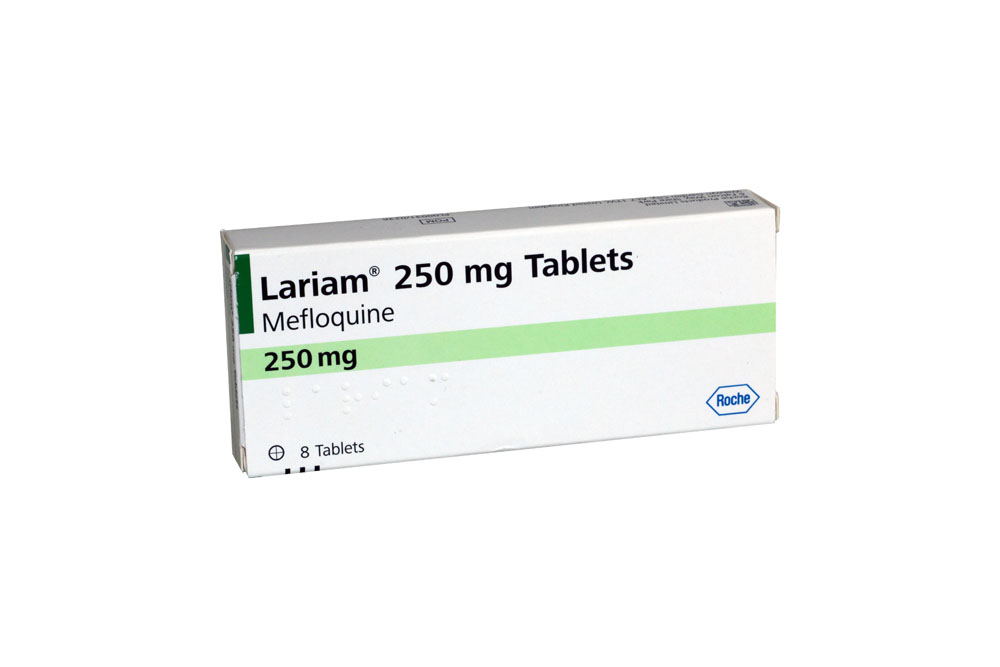 One
Calgary Voter
Poison Pill: The Story of mefloquine From The Laboratory To The
Courtroom One
Calgary Voter
Poison Pill: The Story of mefloquine From The Laboratory To The
Courtroom
Derek B. Cooper
Mefloquine April 2,
2019 7 Minutes Part 3: Psycho Tuesday and Wacky Wednesday
https://onecalgaryvoter.com
VVi 02 Apr 2019 db

In the May 8th, 1989 edition of the New York Times, an
insignificant looking article is reporting the FDA approval of the
new anti-malaria drug, Lariam. It notes the drug’s developer, the
Army Medical Research and Development Command, as well as
Hoffmann-La Roche and the World Health Organization, both of whom
collaborated on the project with the army.
It goes on to
state further that malaria infects between 300-400 million people
annually, and 3-5 million will die of the disease. American world
travelers can now do so without fear of contracting malaria, thanks
to the good people at Roche Pharmaceuticals, the WHO, and the United
States Army.
A Warning Goes Unheeded
Then, in
November, a letter was sent to the New England Journal of Medicine
by three doctors from the Centres for Disease Control in Atlanta. It
is the first appearance in the literature of mefloquine induced
psychosis as an adverse reaction. To quote the article:
The
recent licensure of mefloquine in the United States has important
implications for the protection of visitors to areas with
chloroquine-resistant P. falciparum malaria. To clarify the
absorption and metabolism of mefloquine, we conducted a
pharmacokinetic study in healthy American adults. We found an
unexpectedly high rate of adverse drug reactions.
Three
subjects (43 percent) had neurologic symptoms that were severe
enough to impair normal functioning for 3 to 14 days. All reactions
were transient and resolved spontaneously. Individual reactions
varied greatly and did not correlate with blood mefloquine
concentrations or pharmacokinetic variables (elimination half-life,
peak concentration, and time of peak concentration;
The
level of the acid metabolite peaked at 14 days, long enough after
the onset of adverse reactions to suggest that the symptoms resulted
predominantly from the parent drug.
The high incidence of
neurologic impairment after a therapeutic dose of mefloquine is a
cause for concern, and it appears to be substantially higher than
that found previously. In French travelers receiving mefloquine for
malaria, the drug has been reported to cause severe neurologic
toxicity, including seizures and psychosis.6 , 7 More information
must be gathered to determine whether such reactions occur with the
prophylactic use of mefloquine. Such side effects could dissuade the
traveler from complying with the prophylactic regimen. It also must
be determined whether psychomotor function is sufficiently impaired
to pose a risk for persons using mefloquine.
Leslie C.
Patchen, M.S.
Carlos C. Campbell, M.D., M.P.H.
Sharyon B.
Williams, B.S.
Centers for Disease Control, Atlanta, GA 30333
It would be a bombshell revelation. Previous clinical trials had
demonstrated very low rates of adverse events, and this report flew
in the face of the findings from the other trials.
Another
letter was sent to The Lancet in April 1990 by doctors from the
Armed Forces Institute of Medical Sciences in Bangkok which read in
part:
Neurological reactions, ranging from dizziness and
inability to concentrate to psychotic reactions,” after mefloquine
treatment and prophylaxis have raised the question of the risks of
mefloquine prophylaxis. This is of special concern to doctors who
have to recommend prophylaxis for those travelling to regions with
multiply resistant Plasmodium falciparum. We report our experience
with mefloquine prophylaxis in US soldiers training in Thailand for
6 weeks in 1988.
Armed Forces Institute of Medical Sciences,
Bangkok 10400, Thailand JAMES D. ARTHUR G. DENNIS SHANKS PETER
ECHEVERRIA
A pattern was beginning to emerge. In the first
three years of the 1990’s, hundreds, perhaps thousands of studies
and trials were being conducted on mefloquine, testing it in various
combinations and in various scenarios. It was typically performed
well in these studies, and although there were reports of severe
psychological effects, these were reported as being rare, and
usually another factor is thought to be involved such as drug or
alcohol abuse.
But letters were starting to be seen in a
myriad of medical journals, that were contradicting the positive
results of the studies. They were all saying the same thing, which
was that mefloquine was a dangerous drug to be avoided.
Unfortunately, those warnings went unheard, or unheeded, and in 1993
it would lead to tragedy.
Somalia

Somalia Civil War, 1992
In 1992, Somalia was a lawless failed
state, ruled by warlords. In order to help establish order, the
United Nations sponsored a humanitarian effort that would also
monitor a brokered cease fire in the country. It was known as UNOSOM
I, and would run until December of that year.
It was replaced
by UNITAF, the United Task Force, which was not run under the
auspices on the UN, but rather was a task force spearheaded by the
U.S., with other countries, including Canada participating. The
Canadian contingent would consist of a battle group from the
Canadian Airborne Regiment.
From the outset, the Canadian
mission was plagued by controversy. The selection of the Airborne
Regiment for this particular assignment was a matter of great
discussion and debate, and the argument is still made today.
Initially, the mission was intended to be strictly of a humanitarian
and peace-keeping nature, but things began to become complicated
when the mission would later allow for the troops to be fully armed,
and they began to prepare for a combat mission. The continual
changes to the rules of engagement would contribute to the stressful
situation on the ground.
This made the Airborne Regiment an
odd choice for this assignment. Typically, peace-keeping missions
will involve unarmed troops, they carry their weapons but they are
not loaded. The requirements involve observing a more defensive
posture, such as setting up camp perimeters, conducting routine
patrols, observing activity, as well as performing a number of
humanitarian tasks in the surrounding area. These duties are part of
being a soldier in an infantry regiment, like the Princess
Patricia’s Canadian Light Infantry, who had a great deal of
experience in conducting peace-keeping operations at the time.
The Airborne Regiment however was different. Meant to be the
“tip of the spear” in combat operations, the Airborne Regiment
consisted of the best of the best from all three Canadian infantry
regiments. Like all elite military forces, they were a highly
trained and motivated machine, whose sole purpose was to kill. It
takes a certain mindset to do a job like that, and it get drilled
into these troops relentlessly. Many, including myself, felt and
still feel that it wasn’t an appropriate choice and that it ran
counter to conventional military doctrine and thinking.
Another controversy arose when it was discovered that the regiment
had some serious issues with racism. It had been well established
that racist and white supremacist elements existed within the
regiment. In the the portraits of Airborne members from that period,
a Confederate flag can be seen hanging in the background beside the
Canadian flag. The regiment was also known to have problems with
discipline, and there were questions as to whether officers were
exercising proper control over their troops.
Nevertheless,
the regiment would be sent to Somalia in December, but before they
left the men had to begin malaria prophylaxis. The drug they were
given hadn’t been approved for use in Canada at the time, and so
they were to be given the medication as part of a clinical drug
trial. The drug was mefloquine.
Drug Mistrial

Establishing a Machine Gun Emplacement, 1993
The facts are
laid out in an article in the Lancet, one of the oldest and most
respected peer-reviewed medical journals in the world. An article in
the May 1999 edition gives the details about how the military
acquired the drug, and the impression that I am left with is that it
did so through fraudulent means.
The medication had been
given to the military by the sponsor of the study, presumably the
manufacturer. In order to participate in the study, strict reporting
protocols have to be adhered to. Detailed records would need to be
kept, and adverse reactions would need to be reported immediately,
and symptoms thoroughly documented. The health records of the
participants would also have to be checked to screen for potential
problems, such as a history of depression or other mental illness.
What happened next could be summed up with an expression often
used in the military. It was a cluster-fuck. There was no effort
what so ever to record anything, measure anything, observe anything,
or report anything. The men were told that they were being given an
anti-malarial drug, and were told what the potential side effects
were as they appeared on the monograph. They were unaware of the
fact that they were supposed to be taking part in a clinical trial,
and had not been given the proper informed consent.
Speaking
as someone who is not in the legal profession, common sense tells me
that two crimes have been committed here. First, the military acted
with a blatant disregard for the lives of these men that resulted in
harm, and are also culpable in the deaths of two Somali teenagers.
Second, by obtaining the drugs for the study having never intended
to perform the work required, they committed fraud by deception. I
realize that there will never be any recriminations for this, but I
figured I’d put it out there anyway.
It is clear from the
evidence gathered to this point, that many of the soldiers who were
in Somalia were suffering severe adverse reactions to mefloquine.
There are accounts of men experiencing hallucinations, psychosis,
severe depression, and other severe psychological symptoms. The
symptoms were the worst on the day they received their weekly dosage
of mefloquine. Depending upon the day of the week, these days were
known among the men as either “Psycho Tuesday” or “Wacko Wednesday”.
It is evident that mefloquine played a major role in the events
that took place in Somalia, in fact I’d go so far as to say that two
Somali teens would not have been killed, Master Corporal Clayton
Matchee wouldn’t have attempted suicide, and Trooper Kyle Brown
wouldn’t have spent time in prison. It is also likely that the
Airborne Regiment wouldn’t have wound up being disbanded in
disgrace.
Reopening the Somalia Inquiry

Somalia Commission Chairman, Justice Gilles Letourneau
The
Somalia Commission of Inquiry ended in 1997, unfinished and
incomplete. The overwhelming body of evidence about mefloquine needs
to be added to the record, and the final report amended to reflect
the new information.
Perhaps most importantly, this
information must be considered when taking into account the
miscarriage of justice that has occurred with regards to Clayton
Matchee and Kyle Brown. They have carried the burden of the blame
for what happened, and their names need to be cleared. Their actions
were reprehensible, but in the absence of mefloquine they would not
have occurred.
Since only the Prime Minister and cabinet are
capable of doing so, I am calling upon them to re-sit the Commission
and give Justice Letourneau a new mandate. Justice demands it, and
so do a large number of veterans and the Canadians who support them,
like myself.
See more... |